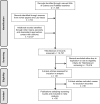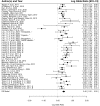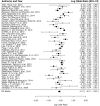A Meta-Analysis of the Association between Gender and Protective Behaviors in Response to Respiratory Epidemics and Pandemics - PubMed (original) (raw)
Meta-Analysis
A Meta-Analysis of the Association between Gender and Protective Behaviors in Response to Respiratory Epidemics and Pandemics
Kelly R Moran et al. PLoS One. 2016.
Abstract
Respiratory infectious disease epidemics and pandemics are recurring events that levy a high cost on individuals and society. The health-protective behavioral response of the public plays an important role in limiting respiratory infectious disease spread. Health-protective behaviors take several forms. Behaviors can be categorized as pharmaceutical (e.g., vaccination uptake, antiviral use) or non-pharmaceutical (e.g., hand washing, face mask use, avoidance of public transport). Due to the limitations of pharmaceutical interventions during respiratory epidemics and pandemics, public health campaigns aimed at limiting disease spread often emphasize both non-pharmaceutical and pharmaceutical behavioral interventions. Understanding the determinants of the public's behavioral response is crucial for devising public health campaigns, providing information to parametrize mathematical models, and ultimately limiting disease spread. While other reviews have qualitatively analyzed the body of work on demographic determinants of health-protective behavior, this meta-analysis quantitatively combines the results from 85 publications to determine the global relationship between gender and health-protective behavioral response. The results show that women in the general population are about 50% more likely than men to adopt/practice non-pharmaceutical behaviors. Conversely, men in the general population are marginally (about 12%) more likely than women to adopt/practice pharmaceutical behaviors. It is possible that factors other than pharmaceutical/non-pharmaceutical status not included in this analysis act as moderators of this relationship. These results suggest an inherent difference in how men and women respond to epidemic and pandemic respiratory infectious diseases. This information can be used to target specific groups when developing non-pharmaceutical public health campaigns and to parameterize epidemic models incorporating demographic information.
Conflict of interest statement
The authors have declared that no competing interests exist.
Figures
Fig 1. Preferred Reporting Items for Systematic Reviews and Meta-Analyses (PRISMA) flow diagram of search strategy.
A flow diagram providing the organization of the article search and selection process along with values for article retention numbers at each state.
Fig 2. Map of global study distribution.
A map visualizing the number of studies addressing populations from each country.
Fig 3. Density graph showing the sets of log odds ratios for pharmaceutical and non-pharmaceutical behaviors addressed for the 88 included study populations.
Males are used as the reference; positive log odds ratios correspond to females being more likely to adopt/practice a given behavior, and negative log odds ratios correspond to males being more likely to adopt/practice a given behavior. The set of non-pharmaceutical behaviors shown is trimmed such that the log odds ratio falling outside of three standard deviations from the mean is excluded.
Fig 4. Forest plot of the associations between gender and non-pharmaceutical behaviors.
The effect size and confidence interval of each study are indicated by a square and a horizontal line, respectively. The weight of each study in the model is indicated by the size of its square. A log odds ratio of 0, indicated by the dashed reference line, corresponds to no gender difference in behavioral response. Positive log odds ratios correspond to greater behavioral response by females, while negative log odds ratios correspond to greater behavioral response by males. The population mean effect size of the random-effects model incorporating these studies is given by the placement of the diamond, while the horizontal corners of the diamond illustrate the 95% CI of this mean effect size.
Fig 5. Forest plot of the associations between gender and pharmaceutical behaviors.
The effect size and confidence interval of each study are indicated by a square and a horizontal line, respectively. The weight of each study in the model is indicated by the size of its square. A log odds ratio of 0, indicated by the dashed reference line, corresponds to no gender difference in behavioral response. Positive log odds ratios correspond to greater behavioral response by females, while negative log odds ratios correspond to greater behavioral response by males. The population mean effect size of the random-effects model incorporating these studies is given by the placement of the diamond, while the horizontal corners of the diamond illustrate the 95% CI of this mean effect size. Publications with the same author(s) and year of publication are differentiated by the first word of their title. Publications including multiple studies are denoted by labeling the studies A, B, etc.
Similar articles
- Protective practices and respiratory illness among US travelers to the 2009 Hajj.
Balaban V, Stauffer WM, Hammad A, Afgarshe M, Abd-Alla M, Ahmed Q, Memish ZA, Saba J, Harton E, Palumbo G, Marano N. Balaban V, et al. J Travel Med. 2012 May-Jun;19(3):163-8. doi: 10.1111/j.1708-8305.2012.00602.x. J Travel Med. 2012. PMID: 22530823 - Reflecting on prediction strategies for epidemics: Preparedness and public health response.
Yildirim M, Serban N, Shih J, Keskinocak P. Yildirim M, et al. Ann Allergy Asthma Immunol. 2021 Apr;126(4):338-349. doi: 10.1016/j.anai.2020.11.017. Epub 2020 Dec 9. Ann Allergy Asthma Immunol. 2021. PMID: 33307158 Free PMC article. Review. - Adoption of preventive behaviors in response to the 2009 H1N1 influenza pandemic: a multiethnic perspective.
SteelFisher GK, Blendon RJ, Kang M, Ward JR, Kahn EB, Maddox KE, Lubell KM, Tucker M, Ben-Porath EN. SteelFisher GK, et al. Influenza Other Respir Viruses. 2015 May;9(3):131-42. doi: 10.1111/irv.12306. Influenza Other Respir Viruses. 2015. PMID: 25688806 Free PMC article. - Spatially-implicit modelling of disease-behaviour interactions in the context of non-pharmaceutical interventions.
Ringa N, Bauch CT. Ringa N, et al. Math Biosci Eng. 2018 Apr 1;15(2):461-483. doi: 10.3934/mbe.2018021. Math Biosci Eng. 2018. PMID: 29161845 - Behavioral Counseling Interventions to Prevent Sexually Transmitted Infections: A Systematic Evidence Review for the U.S. Preventive Services Task Force [Internet].
Henderson JT, Henninger M, Bean SI, Senger CA, Redmond N, O’Connor EA. Henderson JT, et al. Rockville (MD): Agency for Healthcare Research and Quality (US); 2020 Aug. Report No.: 19-05260-EF-1. Rockville (MD): Agency for Healthcare Research and Quality (US); 2020 Aug. Report No.: 19-05260-EF-1. PMID: 32970399 Free Books & Documents. Review.
Cited by
- Gender differences in COVID-19-related behaviours: evidence from three ethnic minority groups.
Maryniak JR, Lubiewska K, Olko J. Maryniak JR, et al. Curr Issues Personal Psychol. 2024 Feb 23;12(3):210-216. doi: 10.5114/cipp/178416. eCollection 2024. Curr Issues Personal Psychol. 2024. PMID: 39184901 Free PMC article. - Cross-Sectional Survey of Factors Contributing to COVID-19 Testing Hesitancy Among US Adults at Risk of Severe Outcomes from COVID-19.
Assaf AR, Sidhu GS, Soni A, Cappelleri JC, Draica F, Herbert C, Arham I, Bader M, Jimenez C, Bois M, Silvester E, Meservey J, Eng V, Nelson M, Cai Y, Nangarlia A, Tian Z, Liu Y, Watt S. Assaf AR, et al. Infect Dis Ther. 2024 Jul;13(7):1683-1701. doi: 10.1007/s40121-024-01001-5. Epub 2024 Jun 13. Infect Dis Ther. 2024. PMID: 38869840 Free PMC article. - Gendered Consequences of COVID-19 Among Professional Tennis Players.
Cary M, Stephens H. Cary M, et al. J Sports Econom. 2023 Feb;24(2):241-266. doi: 10.1177/15270025221120591. J Sports Econom. 2023. PMID: 38603132 Free PMC article. - Meta-analysis of KAP toward COVID-19 in Chinese residents.
Deng J, Fang Y, Wang Q, Tian Y, Wang S, Yang Y, Yang D, Li S. Deng J, et al. Front Public Health. 2024 Mar 1;12:1279293. doi: 10.3389/fpubh.2024.1279293. eCollection 2024. Front Public Health. 2024. PMID: 38496394 Free PMC article. - Identification of factors associated with non-adherence to recommended COVID-19 preventive behaviours: a cross-sectional study based on a survey among 1004 French primary care professionals.
Bouton C, Meziere P, Gaultier A, Dupouy J, Rat C; French National College of General Practioners. Bouton C, et al. BMJ Open. 2023 Aug 29;13(8):e071215. doi: 10.1136/bmjopen-2022-071215. BMJ Open. 2023. PMID: 37643842 Free PMC article.
References
- Centers for Disease Control and Prevention (CDC). Severe Acute Respiratory Syndrome (SARS); Accessed September 29, 2015. Available from: http://www.cdc.gov/sars/about/fs-sars.html.
- Flu gov. H5N1 Avian Flu; Accessed September 29, 2015. Available from: http://www.flu.gov/about_the_flu/h5n1/index.html.
- Dawood FS, Iuliano AD, Reed C, Meltzer MI, Shay DK, Cheng PY, et al. Estimated global mortality associated with the first 12 months of 2009 pandemic influenza A H1N1 virus circulation: a modelling study. The Lancet infectious diseases. 2012;12(9):687–695. 10.1016/S1473-3099(12)70121-4 - DOI - PubMed
- Flu gov. About Pandemics; Accessed August 24, 2015. Available from: http://www.flu.gov/pandemic/about/index.html.
Publication types
MeSH terms
LinkOut - more resources
Full Text Sources
Other Literature Sources




